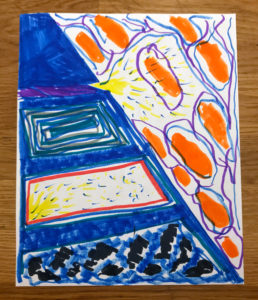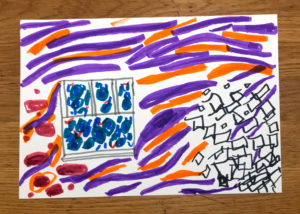
Thornton Dial was a Black American artist known for works of art that combine everyday materials and vivid colors. He was born in rural Alabama on a former plantation. For most of his life, he made art for himself while working in a metal plant. In the 1980s, a collector discovered his work, and Dial became very important and well known as an artist.
This work of art depicts the spirit of Grand Central Station — the main train station in New York City. Dial visited Grand Central while on trips to New York. He created the work after he noticed people experiencing homelessness there. About 750,000 people travel through the Grand Central on an average day. The station includes restaurants, shops, subway stops and train platforms. Check out the colors and patterns Dial uses to show this place. What kinds of sights and sounds do you think he might be representing? Are they loud or quiet? Busy or calm?
To make art, Dial explained, “You start off with a vision in your mind, just like a blueprint for a house in your head,” and “Everything got a pattern for it. The pattern for a piece of art is in your mind.” In this activity, you’ll listen to the sounds around you and create a drawing based on what you hear and the patterns you imagine.
 Thornton Dial Sr. (American, 1928 – 2016), “Spirit of Grand Central Station — The Man That Helped the Handicapped,” 1990. Enamel on braided rope carpet and industrial sealing compound on canvas mounted on plywood. 60 × 83 1/2 inches. Georgia Museum of Art, University of Georgia; Gift of Ron and June Shelp. GMOA 2010.315
Thornton Dial Sr. (American, 1928 – 2016), “Spirit of Grand Central Station — The Man That Helped the Handicapped,” 1990. Enamel on braided rope carpet and industrial sealing compound on canvas mounted on plywood. 60 × 83 1/2 inches. Georgia Museum of Art, University of Georgia; Gift of Ron and June Shelp. GMOA 2010.315


For this activity you will need:
- Paper
- Markers, colored pencils or crayons
- An environment with interesting sounds
To draw your soundscape:
- Close your eyes and listen to your environment. Try listening for a little bit before you start drawing. What repeating noises do you hear? What sounds occur suddenly? What do those sounds remind you of?
- Begin drawing the sounds. What colors do the sounds make you think of? Are the sounds you hear smooth and flowing, or short and choppy? Are they loud or soft? Think about what kind of lines, shapes and colors you can use to reflect the flow or feel of the sounds you hear.
- Create a title for your drawing.
- Try moving somewhere else and making another soundscape drawing. You can also try playing music to add to your soundscape! How are the drawings similar or different?